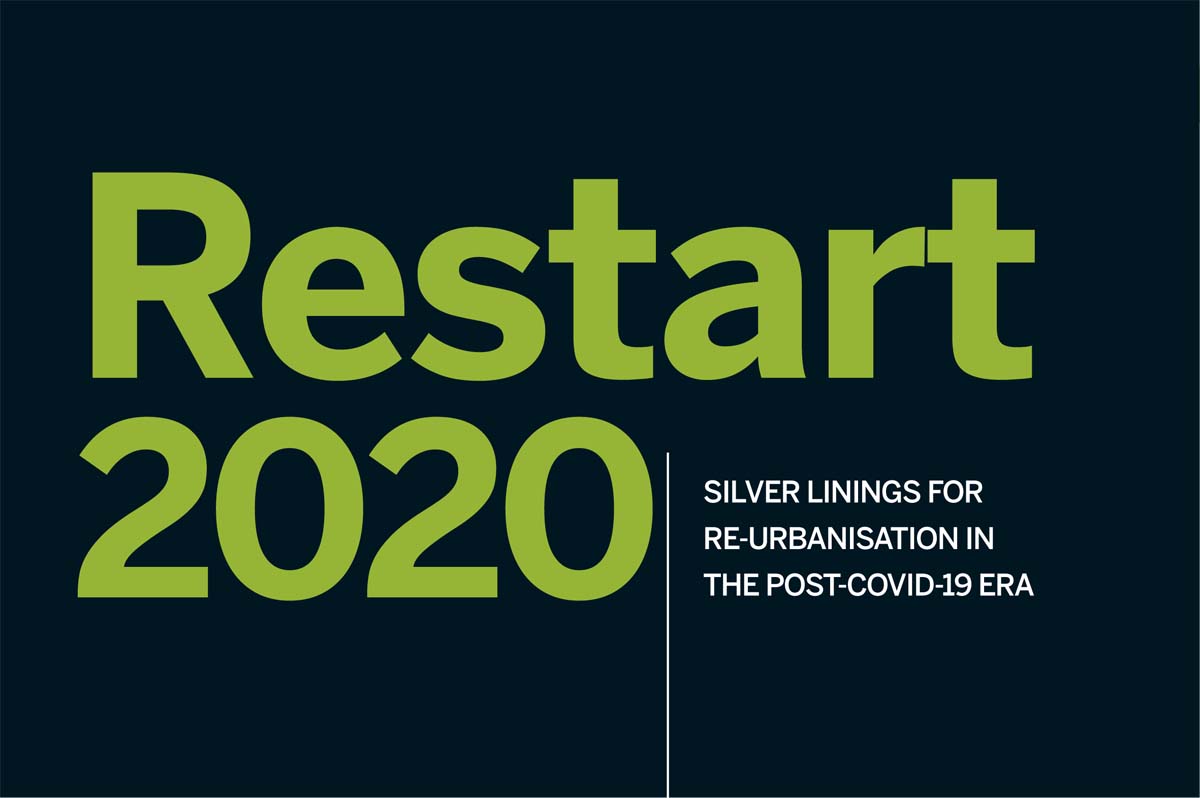The Covid pandemic has brought the business-as-usual world to a grinding halt. And since the problems arising out of it have a big city bias with many metropolises from New York to Mumbai and Milan being the epicentres of infections and deaths, most of these cities as we knew them for their urban vitality have transformed into commons of eerie silence.
As cities across the globe adjust, transform and evolve to ‘restart’ in what is being called ‘the New Normal’, the pause from the ‘hectic-business-as-usual’ urban life has offered us urbanites an opportunity to reflect deeper on our social, economic and environmental actions and the outcome these actions have on the sustainability of our world at large.
We asked seven experts on Urbanisation and Human Settlements from around the world to put down their thoughts on how this crisis could be an opportunity to fundamentally redefine our relationships with one another, our relationship with nature and the environment.
We asked these thought-leaders to point out the silver linings in a world threatened by the dark clouds of this pandemic. Through their extensive work in countries around the world, these professionals represent the interests of a vast number of people and places where they work, from countries in South America and Africa (Claudio Acioly), India, Myanmar and Bangladesh (Maartje van Eerd), Vietnam and Cambodia (Kelly Shannon), Taiwan and Korea (John Jung), Sri Lanka, China and other Asian countries (Nihal Perera) and India (Ashok Lall and Jagan Shah).
The seven experts we invited to contribute to this article are:


Ashok Lall
It has been a long lock-down. All activities except for essential services: food, petrol and ATMs are suspended. More than 80 ‘containment zones’ have been declared in Delhi, where the virus infection has shown up. Markets, offices, construction sites, factories, cinemas, schools, temples and mosques are closed. But despite the lockdown and the containment discipline, the virus continues to spread.
The city has gone eerily quiet and still. You can see a blue sky. Yes, it is still there! You can breathe fresh air and stroll down the lane, now that it is all yours to walk on. And you can enjoy the quiet of the garden and listen to birdsong.
The forced interlude has lifted the layers of stressful congestion and noise and the sickening pall of polluted air. Now we all know the price of hyperactive business-as-usual city life that we have been paying for and suffering through. It seemed to be unsurmountable.
The silence has also revealed the brittle and vulnerable social edifice of the business-as-usual city. It is two cities, divided by wealth and profession. Those whose work is in making things and rendering physical service, the daily wage earners, whose labour maintains the supply of material necessities of life, are in despair. There is no safety net to tide over their ordeal. They are dependent on alms. Those whose work is in transaction of knowledge and information are ensconced in their cushion of wealth, sailing over the Internet, while their basic necessities continue to be met. If the Internet were to break down, their life would too.
Indeed, the Internet, free and easy access to current information on your smart phone, is the lifeline. It is the common denominator on which the resilience of city life rests. Access to reliable and truthful information is perhaps on the way to being democratised.
After Covid, will we return to business-as-usual? There is hope and, perhaps, a new resolve. We could change to a business-that-matters city by focusing on daily needs and necessities produced by small units where most of us work and walkable precincts connected with electric transport. Live light, live gentle, build the basic infrastructure of simple living for all.
The myth of the great multi-storey metropolis, the great engine of innovation and wealth is now dead. That is the most material and energy intensive form of living and the least resilient and most vulnerable too. Its intensity crushes Nature.
Cities that are walk-up cities with a close connection to streets and gardens below and accessible roof terraces above, of compact forms and moderate densities are liveable and affordable. They are homes in the true sense, where the elderly and children are equal citizens. They form natural communities and resilient social units. They have a light environmental footprint, whereby one can retain and enjoy the gifts of Nature.

Kelly Shannon
Shock and disruption force unnatural slowdowns. In the times of the contemporary crisis, unnervingly cocooned in solitary bubbles, we have all had time to think, to be bored, to take stock of our own pasts (and possible futures) and our unavoidable interconnectedness. The priorities and values of individuals and of society have become amplified — for better, for worse, for richer, for poorer, in sickness and in health. As humanity emerges from the global pandemic, the professions of the built environment will undoubtedly face a brave new world. Urbanism has a responsibility to fight to make sure that it becomes a more just world: ecologically, socially, economically and spatially. The crisis incited action and proved that radical change is possible.
Humanity has confirmed that the tragedy of the commons can potentially be averted. A cocktail of scientific reasoning and empathy has led to novel responses and the privileging of the collective over the individual. The selfless dedication to the Hippocratic Oath made essential workers and first responders the heroes of Covid-19. The human to human relation has changed, as has humankind’s to nature. Urbanists must now understand the health crisis as a dress rehearsal for a cascade of other crises: mass migration and homelessness, poverty and social unrest, food and water security and the myriad looming consequences of accelerated climate change and species extinction. The crises can be addressed opportunistically and used as a revolutionary moment, since there can never be a return to ‘normal’.
Urbanism must creatively capitalise on the window of opportunity to boldly rethink humanity’s place in the world: in society and in nature. Urbanists cannot wait for policies, but must preempt them with impassioned projects, which fundamentally restructure the human and non-human web of life. There is a necessity — the mother of invention — for bold urban design and territorial projects.
Urbanism is uniquely able to synthesise ecological systems, scientific data, engineering methods, social practices and cultural values, integrating them into the design of the built environment.
Through the discipline’s creative capacity to reimagine the world, it must urgently develop ways to reduce ecological footprints, enliven and expand public space and re-connect natural rhythms across numerous scales, from the territorial to settlement issues. Urbanists need to construct ways to lessen human and non-human species vulnerability and develop radically reconsidered culture-nature relationships.

Claudio Acioly Jr
The Coronavirus Pandemic has hit cities, their inhabitants, the business sector and the urban economy very hard. When quarantine and strict social distancing measures were adopted, including the freeze on public transportation, entire populations were compelled to retreat from the public domain leaving behind empty public spaces, moribund businesses and a city living in silence and fear of an invisible enemy. Those on the periphery and slums of the cities in the developing world were doubly penalised. This is dramatically evident in cities like Rio de Janeiro and Sao Paulo, Brazil’s and Latin America’s largest metropolises. The retreat of people from the beaches, streets, public spaces and cultural and entertainment places caused a dramatic impact on people operating in the informal sector and living in favelas and popular neighbourhoods and who depend on the economy of agglomeration to earn their daily income and earn a livelihood for their families. The agglomeration of people disappeared abruptly followed by the collapse of the supply chain of several small-scale businesses resulting in bankruptcy of many shops, businesses and loss of jobs following a domino effect.
Besides that, people living in inadequate, poorly serviced and overcrowded housing in the favelas and slums were subject to a myriad effects when forced into confinement in their homes such as high risk of contamination, stress, impoverishment and violence in addition to the loss of their food security and basic income. The pandemic crisis in Rio de Janeiro shows unequivocally that it is the people who run the economy of a city. Take them away, put them in quarantine and the urban economy collapses completely. One of the lessons from this crisis is that public policies ought to be people-centric, to strengthen the human and social capital and produce interconnected social and economic sustainability outcomes within a spatial structure that fosters prosperity. The compact and interconnected city environment is equally essential for the sustainability of businesses and people’s livelihood.
The seclusion of people has led to empty streets where previously the car was the absolute king and air pollution prevailed. Satellite photos monitoring Green House Gas emissions in Rio de Janeiro, São Paulo and Brasilia showed a remarkable decrease when comparing data from 2019 and 2020. This unveils the relevance of environmental sustainability and the carbon footprint of cities that is closely associated with prevailing patterns of urban mobility and the use of motorised and fossil fuel-based means of transportation.
Thus, the pursuit of urban sustainability in the post-pandemic era will bring together people-centeric policies that enhance human and social capital, meeting basic needs and generating jobs and ample opportunities for income generation and poverty reduction. This will be combined with policies that centre on environmental quality. This means quality of life in an urban environment comprises clean air, accessibility to public and green spaces, clean technology employed to public transport and overall urban mobility and increasing non-motorised transportation.
The fact is that the making of the sustainable, resilient, safe and inclusive city... must bring together social, economic, environmental and spatial sustainability in a new generation of public policies under the leadership of city governments and city leaders who have the autonomy, means, resources and legal tools to implement the city we want.

Jagan Shah
The crowded slums of the Indian metropolis offer a fleeting opportunity. Slums have been supplying low-cost rental accommodation to millions of casual labourers and informal workers in environments where social distancing is impossible, severely compromising public health. An exploitative and mafia-managed low-cost, low-standard housing market has survived in the slums for seven decades. The time has come for city governments to work with architects and urbanists to re-evaluate the classist concept of ‘affordable housing’ and understand that the fundamental reason to have housing standards is to preserve and maintain personal and community health. ‘Social housing’ can serve a social purpose by accommodating the ubiquitous workers of the city in locations that are close to the homes and establishments where their services are most required. Long commutes on crowded public transit will be undesirable and this proximity of demand and supply can be a boon for reinventing the urban economy.
The next-generation social housing cluster can rehouse the slum dwellers in minimum two-room dwelling units, with one room available for isolation and care-giving. Healthier layouts would also accommodate regulated work spaces for small and micro-enterprises, allowing women to retain their economic agency. The shift to these new productive clusters would be participatory and preceded by a public education programme that inculcates understanding of personal and family health.
Every working-age individual can be re-skilled for producing goods and services that derive from design-rich and tech-enabled solutions; high on innovation, low on cost of production. These can drive a thriving and profitable circular economy, taking locally produced waste and converting it into new products. These enterprises can be modelled as producer cooperatives and connected to markets through e-commerce, with the principles of Fair Trade ensuring responsible production and social protection.
Social housing designs can accommodate hydroponic cultivation of nutritious herbs and vegetables, which will be needed for building resistance. Residual waste and rooftops can be used to generate renewable energy and achieve the self-sufficiency that will define the new metropolitan culture. The hyper-localisation achieved by such social housing clusters can establish a sustainable ‘work-life’ balance for the body politic and give a fillip to shared prosperity.

John G Jung
One of the silver-linings of the Covid-19 crisis is the nature in which people and communities have learned to come together virtually over web-based platforms to communicate, share experiences, hardships and insights.
According to a former Cisco executive, acceptance of collaborative video-conferencing among government and university departments has been transformed in a matter of weeks, not years. In fact, many organisations experienced regular virtual contact with their employees and undertook to engage in serious work from home using one of the collaborative video-conferencing platforms such as Zoom, Hangout, Skype, WebEx and Teams. Consequently, these ‘pioneers’ also shared their newfound experiences with friends and families around the world. Despite the vicious crisis of Covid-19, communities benefitted from advanced broadband connections and technologies to enable and support these opportunities.
After Covid-19 eventually passes, could we potentially benefit from a real legacy of these applications? One area that this behavioural transformation could be helpful in is to reduce the carbon footprint globally by learning from the lessons gained from these collaborative virtual platforms. Global stay-at-home requirements of countries fighting the Covid-19 crisis have already reduced airline travel and lessened the use of private automobiles around the world. Combined with reduced manufacturing output, striking images from outer space show Wuhan, China, in the early days of the outbreak with a significant reduction in its carbon footprint, greatly helping towards the sustainability of that part of the world.
While we were home huddled around our laptops, there was also much transformation taking place in the physical world outside. For example, streets were empty of carbon-producing car traffic during the pandemic. Consequently, new sustainability-focused ideas are emerging about the creative reuse of streets as places for people to walk and cycle, especially with social distancing in mind.
Designers and decision-makers are also reimagining for greater sustainability through new city-building processes.
Higher density districts could reflect future social distancing strategies in new built-form concepts; designing wider sidewalks for pedestrians and cyclists’ use, and instilling a greater focus on improving the appeal of local neighbourhoods and parks, thereby reducing the desire and need for distance travel through cars and airlines.

Maartje van Eerd
The scale of the global housing problem is enormous: 330 million urban households around the world live in substandard housing or are financially stretched by housing costs. Some 220 million households in the global south live in slums, and about 440 million households around the world – at least 1.6 billion people – are estimated to be occupying crowded, inadequate and unsafe housing or will be financially stretched by 2025 (McKinsey Global Institute, 2014; WRI, 2017).
The pandemic that the world is currently facing has very sharply brought to the forefront the interconnectedness of housing, health and sanitation and food security. It also vividly shows the scale of the challenge with respect to the number of people living in precarious situations worldwide. Those living in informal settlements and in totally inadequate housing, many of whom depend on informal labour, have lost all sources of livelihood due to the lockdown and have to depend on food kitchens for sustenance and, even worse, those huge numbers of people do not even have a roof over their heads.
For those living in slums, social distancing is an illusion, and the sanitary precautions that are advised are almost impossible to realise for the great majority of the inhabitants. How can you wash your hands without access to water?
How is it possible to stay indoors when your family’s food security is at risk and when your house is overcrowded? And what about the homeless? Where can they take shelter? These are some of the very brutal challenges that millions of people affected by the lockdown are now facing in many countries in the global south.
There are many examples in slums and resettlement sites where communities are showing their resilience and are taking initiatives to deal with the current crisis. For instance, in the resettlement site in Perumbakkam in Chennai, India, poor women are organising food packages for those in need in their colony (Narayanan, 2020). Also, governments are providing support in the form of rations, rent suspensions and moratoriums on all evictions in some places.
This crisis forces us to rethink our development model and our ways of meeting the urban challenges. I agree with Arundhati Roy when she writes (FT 2020): “Nothing could be worse than to go back to normality after this pandemic.” Kirtee Shah writes (ACHR E-News 2020), “This crisis gives us the opportunity to rethink the way we live, produce, consume, interact transact, move, grow and develop.” So, what does this mean for the field of housing, and how should we move from here after this pandemic is under control? One of the answers comes from international housing rights. The right to adequate housing is recognised in the International Covenant on Economic, Social and Cultural Rights, (General Comment 4 and 7 of 1991 and 1997 respectively). In 2020 this Covenant has been ratified or acceded to by as many as 170 States, which means they have committed themselves to work towards the progressive realisation of the right to adequate housing.
The momentum of this pandemic not only provides civil society groups, rights based organistions and the international community, but also academia and those educating the future housing and urban management professionals an even stronger argument to persuade governments to allocate sufficient budgets to work with, listen to and learn from communities in order to realise the right to adequate housing for all. This is extremely important from a housing rights perspective as well as from a global health perspective.
At the Institute for Housing and Urban Development Studies (IHS) the housing team is dedicated to educating agents of change for the housing sector to train professionals who will work towards the realisation of housing justice as adequate housing, which is available, accessible, affordable, acceptable and adaptable for all in an equitable, inclusive and sustainable way.

Nihal Perera
It is highly refreshing to see nature ‘bounce back.’ As it pushed humans indoors and stalled the industries and movements, the pandemic brought a stunning change to our environment. Beginning with lions sleeping on roads, elephants visiting institutions, and animals visiting people at home, it transformed the Earth into a reverse-zoo. As Delhi and many Chinese cities emerged ‘pollution-free’ and Sri Lankans viewed the tallest mountain, Sri Pada, from Colombo, the Earth also fixed the largest, one-million-sq km hole in the ozone layer above the Arctic. Although, we do not know what awaits us out there, I wonder whether we could build on the positive changes that emerged.
Jacinda Ardern was clear: “Economic growth is an unnecessary evil.” Unfortunately, the world has been misled to believe economic growth comes in the form of development and massive infrastructure projects built using huge foreign loans. The right-wing populists are yearning to take us back to the old life. In addition to revealing the destruction the growth has caused on the environment, the pandemic has also shown that nature can rejuvenate by itself, only if we allow it to.
Yet, the same kind of thinking that caused the environmental crisis cannot solve it. Humans hold the arrogant worldview that they can know and manage the natural environment and the economy singlehandedly. This is at an impasse.
Instead of searching for an exit strategy from the current limitations, it is time to think of an entrance strategy to the new world.
Nature is not a child; it can take care of itself. The tsunamis, flooding and climate change clearly indicate that humans cannot subjugate the Earth’s processes, and that an attempt to recover can be detrimental to human living. Natural disasters keep reminding us of the need to live with nature, not assuming that we can classify and categorise its contents, turning it into a boring context for our lives made up of a few economically-useful plants and animals. It is time to enjoy life, i.e. to find ways to leave nature (or parts of it) alone, accept its autonomy, and enjoy being in it, causing the smallest ecological footprint possible.


Comments (0)